A Comprehensive Review of Hollow-Fiber Membrane Fabrication Methods across Biomedical, Biotechnological, and Environmental Domains
Abstract
:1. Introduction
2. Hollow-Fiber Membrane Preparation
2.1. The Spinning Process Parameters for Hollow-Fiber Membranes
2.1.1. Changes in Polymer Extrusion Velocity, Pressure, Temperature, Bore Fluid, and Air Gap
2.1.2. Polymer Solution and/or Bore Fluid Modifications
2.2. Preparation of Multi-Component Membranes
2.2.1. Blend Membrane Fabrication
2.2.2. Degradable-Blend Membranes
2.2.3. Dual-Layer Membranes
2.3. Corrugated Membranes
3. Conclusions
Author Contributions
Funding
Conflicts of Interest
References
- Ferrera, E.; Ruigómez, I.; Vera, L. Pilot scale application of a rotating hollow fibre membrane for direct membrane filtration of domestic wastewater. J. Water Process. Eng. 2024, 58, 104755. [Google Scholar] [CrossRef]
- Goh, K.S.; Chong, J.Y.; Chen, Y.; Fang, W.; Bae, T.-H.; Wang, R. Thin-film composite hollow fibre membrane for low pressure organic solvent nanofiltration. J. Membr. Sci. 2020, 597, 117760. [Google Scholar] [CrossRef]
- Jonkers, W.A.; Cornelissen, E.R.; de Vos, W.M. Hollow fiber nanofiltration: From lab-scale research to full-scale applications. J. Membr. Sci. 2023, 669, 121234. [Google Scholar] [CrossRef]
- Sikorska, W.; Wasyłeczko, M.; Przytulska, M.; Wojciechowski, C.; Rokicki, G.; Chwojnowski, A. Chemical degradation of psf-pur blend hollow fiber membranes—Assessment of changes in properties and morphology after hydrolysis. Membranes 2021, 11, 51. [Google Scholar] [CrossRef] [PubMed]
- Sikorska, W.; Przytulska, M.; Wasyłeczko, M.; Wojciechowski, C.; Kulikowski, J.L.; Chwojnowski, A. Influence of hydrolysis, solvent and PVP addition on the porosity of psf/pur blend partly degradable hollow fiber membranes evaluated using the MeMoExplorer software. Desalination Water Treat. 2021, 214, 114–119. [Google Scholar] [CrossRef]
- Chwojnowski, A.; Wojciechowski, C.; Dudziński, K.; Łukowska, E. Polysulphone and polyethersulphone hollow fiber membranes with developed inner surface as material for bio-medical applications. Biocybern. Biomed. Eng. 2009, 29, 47–59. [Google Scholar]
- Unger, R.; Huang, Q.; Peters, K.; Protzer, D.; Paul, D.; Kirkpatrick, C. Growth of human cells on polyethersulfone (PES) hollow fiber membranes. Biomaterials 2005, 26, 1877–1884. [Google Scholar] [CrossRef] [PubMed]
- Fukuda, M.; Saomoto, H.; Shimizu, T.; Namekawa, K.; Sakai, K. Observation and proposed measurements of three-dimensional tortuous capillary pores with depth for hollow fiber hemoconcentrator membrane using dynamic force microscopy. Adv. Biomed. Eng. 2019, 8, 145–152. [Google Scholar] [CrossRef]
- PES Hollow Fiber Dialyzer (High-Flux Series). Available online: https://www.peony-medical.com (accessed on 6 May 2024).
- Said, N.; Lau, W.J.; Ho, Y.-C.; Lim, S.K.; Abidin, M.N.Z.; Ismail, A.F. A review of commercial developments and recent laboratory research of dialyzers and membranes for hemodialysis application. Membranes 2021, 11, 767. [Google Scholar] [CrossRef]
- Ahmed, H.M.M.; Salerno, S.; Piscioneri, A.; Khakpour, S.; Giorno, L.; De Bartolo, L. Human liver microtissue spheroids in hollow fiber membrane bioreactor. Colloids Surf. B Biointerfaces 2017, 160, 272–280. [Google Scholar] [CrossRef]
- Wasyłeczko, M.; Wojciechowski, C.; Chwojnowski, A. Polyethersulfone Polymer for Biomedical Applications and Biotechnology. Int. J. Mol. Sci. 2024, 25, 4233. [Google Scholar] [CrossRef]
- Wasyłeczko, M.; Sikorska, W.; Chwojnowski, A. Review of synthetic and hybrid scaffolds in cartilage tissue engineering. Membranes 2020, 10, 348. [Google Scholar] [CrossRef] [PubMed]
- Modi, A.; Verma, S.K.; Bellare, J. Hydrophilic ZIF-8 decorated GO nanosheets improve biocompatibility and separation performance of polyethersulfone hollow fiber membranes: A potential membrane material for bioartificial liver application. Mater. Sci. Eng. C 2018, 91, 524–540. [Google Scholar] [CrossRef] [PubMed]
- Khulbe, K.C.; Matsuura, T. Recent progress in polymeric hollow-fibre membrane preparation and applications. Membr. Technol. 2016, 2016, 7–13. [Google Scholar] [CrossRef]
- Sikorska, W.; Milner-Krawczyk, M.; Wasyłeczko, M.; Wojciechowski, C.; Chwojnowski, A. Biodegradation process of psf-pur blend hollow fiber membranes using escherichia coli bacteria—Evaluation of changes in properties and porosity. Polymers 2021, 13, 1311. [Google Scholar] [CrossRef] [PubMed]
- Matveev, D.N.; Anokhina, T.S.; Volkov, V.V.; Borisov, I.L.; Volkov, A.V. Fabrication of Hollow Fiber Membranes: Effect of Process Parameters (Review). Membr. Membr. Technol. 2023, 5, S1–S21. [Google Scholar] [CrossRef]
- Hasbullah, H.; Kumbharkar, S.; Ismail, A.; Li, K. Preparation of polyaniline asymmetric hollow fiber membranes and investigation towards gas separation performance. J. Membr. Sci. 2011, 366, 116–124. [Google Scholar] [CrossRef]
- Liu, H.; Xiao, C.; Hu, X.; Liu, M. Post-treatment effect on morphology and performance of polyurethane-based hollow fiber membranes through melt-spinning method. J. Membr. Sci. 2013, 427, 326–335. [Google Scholar] [CrossRef]
- Loh, C.H.; Wang, R. Fabrication of PVDF hollow fiber membranes: Effects of low-concentration Pluronic and spinning conditions. J. Membr. Sci. 2014, 466, 130–141. [Google Scholar] [CrossRef]
- Deng, K.; Liu, Z.; Luo, F.; Xie, R.; He, X.-H.; Jiang, M.-Y.; Ju, X.-J.; Wang, W.; Chu, L.-Y. Controllable fabrication of polyethersulfone hollow fiber membranes with a facile double co-axial microfluidic device. J. Membr. Sci. 2017, 526, 9–17. [Google Scholar] [CrossRef]
- Li, Y.; Cao, B.; Li, P. Fabrication of PMDA-ODA hollow fibers with regular cross-section morphologies and study on the formation mechanism. J. Membr. Sci. 2017, 544, 1–11. [Google Scholar] [CrossRef]
- Yucel, H.; Culfaz-Emecen, P.Z. Helical hollow fibers via rope coiling: Effect of spinning conditions on geometry and membrane morphology. J. Membr. Sci. 2018, 559, 54–62. [Google Scholar] [CrossRef]
- Zhang, B.; Lu, C.; Liu, Y.; Zhou, P.; Yu, Z.; Yuan, S. Wet spun polyacrylonitrile-based hollow-mesoporous fibers with different draw ratios. Polymer 2019, 179, 121618. [Google Scholar] [CrossRef]
- Radjabian, M.; Koll, J.; Buhr, K.; Handge, U.A.; Abetz, V. Hollow fiber spinning of block copolymers: Influence of spinning conditions on morphological properties. Polymer 2013, 54, 1803–1812. [Google Scholar] [CrossRef]
- Liu, M.; Xiao, C.; Hu, X. Optimization of polyurethane-based hollow fiber membranes morphology and performance by post-treatment methods. Desalination 2011, 275, 133–140. [Google Scholar] [CrossRef]
- Khayet, M.; Cojocaru, C.; Essalhi, M.; García-Payo, M.; Arribas, P.; García-Fernández, L. Hollow fiber spinning experimental design and analysis of defects for fabrication of optimized membranes for membrane distillation. Desalination 2012, 287, 146–158. [Google Scholar] [CrossRef]
- Li, Y.; Lim, C.T.; Kotaki, M. Study on structural and mechanical properties of porous PLA nanofibers electrospun by chan-nel-based electrospinning system. Polymer 2015, 56, 572–580. [Google Scholar] [CrossRef]
- Bakeri, G.; Ismail, A.; DashtArzhandi, M.R.; Matsuura, T. Porous PES and PEI hollow fiber membranes in a gas–liquid contacting process—A comparative study. J. Membr. Sci. 2014, 475, 57–64. [Google Scholar] [CrossRef]
- Wang, T.; Zhao, C.; Li, P.; Li, Y.; Wang, J. Fabrication of novel poly(m-phenylene isophthalamide) hollow fiber nanofiltration membrane for effective removal of trace amount perfluorooctane sulfonate from water. J. Membr. Sci. 2015, 477, 74–85. [Google Scholar] [CrossRef]
- Liu, H.; Chen, Y.; Zhang, K.; Wang, C.; Zhang, Y. Poly(vinylidene fluoride) hollow fiber membrane for high-efficiency sep-aration of dyes-salts. J. Membr. Sci. 2019, 578, 43–52. [Google Scholar] [CrossRef]
- Wang, Z.; Lin, J.; Zhang, D.; Xun, B.; Yin, J.; Qian, J.; Dai, G.; Zhang, N.; Weng, X.; Huang, Y.; et al. Porous morphology and mechanical properties of poly(lactide-co-glycolide) hollow fiber membranes governed by ternary-phase inversion. J. Membr. Sci. 2019, 579, 180–189. [Google Scholar] [CrossRef]
- Figoli, A.; Simone, S.; Criscuoli, A.; Al-Jlil, S.; Al Shabouna, F.; Al-Romaih, H.; Di Nicolò, E.; Al-Harbi, O.; Drioli, E. Hollow fibers for seawater desalination from blends of PVDF with different molecular weights: Morphology, properties and VMD performance. Polymer 2014, 55, 1296–1306. [Google Scholar] [CrossRef]
- Jones, C.; Gordeyev, S.; Shilton, S. Poly(vinyl chloride) (PVC) hollow fibre membranes for gas separation. Polymer 2011, 52, 901–903. [Google Scholar] [CrossRef]
- Simone, S.; Figoli, A.; Criscuoli, A.; Carnevale, M.C.; Rosselli, A.; Drioli, E. Preparation of hollow fibre membranes from PVDF/PVP blends and their application in VMD. J. Membr. Sci. 2010, 364, 219–232, Erratum in J. Membr. Sci. 2011, 369, 569. [Google Scholar] [CrossRef]
- Su, J.; Yang, Q.; Teo, J.F.; Chung, T.-S. Cellulose acetate nanofiltration hollow fiber membranes for forward osmosis processes. J. Membr. Sci. 2010, 355, 36–44. [Google Scholar] [CrossRef]
- Mansourizadeh, A.; Ismail, A.; Abdullah, M.; Ng, B. Preparation of polyvinylidene fluoride hollow fiber membranes for CO2 absorption using phase-inversion promoter additives. J. Membr. Sci. 2010, 355, 200–207. [Google Scholar] [CrossRef]
- Kopeć, K.; Dutczak, S.; Wessling, M.; Stamatialis, D. Chemistry in a spinneret—On the interplay of crosslinking and phase inversion during spinning of novel hollow fiber membranes. J. Membr. Sci. 2011, 369, 308–318. [Google Scholar] [CrossRef]
- Wongchitphimon, S.; Wang, R.; Jiraratananon, R.; Shi, L.; Loh, C.H. Effect of polyethylene glycol (PEG) as an additive on the fabrication of polyvinylidene fluoride-co-hexafluropropylene (PVDF-HFP) asymmetric microporous hollow fiber membranes. J. Membr. Sci. 2011, 369, 329–338. [Google Scholar] [CrossRef]
- Shibutani, T.; Kitaura, T.; Ohmukai, Y.; Maruyama, T.; Nakatsuka, S.; Watabe, T.; Matsuyama, H. Membrane fouling properties of hollow fiber membranes prepared from cellulose acetate derivatives. J. Membr. Sci. 2011, 376, 102–109. [Google Scholar] [CrossRef]
- Loh, C.H.; Wang, R.; Shi, L.; Fane, A.G. Fabrication of high performance polyethersulfone UF hollow fiber membranes using amphiphilic Pluronic block copolymers as pore-forming additives. J. Membr. Sci. 2011, 380, 114–123. [Google Scholar] [CrossRef]
- Naim, R.; Ismail, A.; Mansourizadeh, A. Preparation of microporous PVDF hollow fiber membrane contactors for CO2 stripping from diethanolamine solution. J. Membr. Sci. 2012, 392–393, 29–37. [Google Scholar] [CrossRef]
- Hasbullah, H.; Kumbharkar, S.; Ismail, A.; Li, K. Asymmetric hollow fibre membranes based on ring-substituted polyaniline and investigation towards its gas transport properties. J. Membr. Sci. 2012, 397–398, 38–50. [Google Scholar] [CrossRef]
- Hou, D.; Wang, J.; Sun, X.; Ji, Z.; Luan, Z. Preparation and properties of PVDF composite hollow fiber membranes for de-salination through direct contact membrane distillation. J. Membr. Sci. 2012, 405, 185–200. [Google Scholar] [CrossRef]
- Abed, M.M.; Kumbharkar, S.; Groth, A.M.; Li, K. Ultrafiltration PVDF hollow fibre membranes with interconnected bicontinuous structures produced via a single-step phase inversion technique. J. Membr. Sci. 2012, 407–408, 145–154. [Google Scholar] [CrossRef]
- Yao, J.; Wang, K.; Ren, M.; Liu, J.Z.; Wang, H. Phase inversion spinning of ultrafine hollow fiber membranes through a single orifice spinneret. J. Membr. Sci. 2012, 421–422, 8–14. [Google Scholar] [CrossRef]
- Naim, R.; Ismail, A.; Mansourizadeh, A. Effect of non-solvent additives on the structure and performance of PVDF hollow fiber membrane contactor for CO2 stripping. J. Membr. Sci. 2012, 423–424, 503–513. [Google Scholar] [CrossRef]
- Ma, C.; Koros, W.J. High-performance ester-crosslinked hollow fiber membranes for natural gas separations. J. Membr. Sci. 2012, 428, 251–259. [Google Scholar] [CrossRef]
- Lang, W.-Z.; Shen, J.-P.; Zhang, Y.-X.; Yu, Y.-H.; Guo, Y.-J.; Liu, C.-X. Preparation and characterizations of charged poly(vinyl butyral) hollow fiber ultrafiltration membranes with perfluorosulfonic acid as additive. J. Membr. Sci. 2013, 430, 1–10. [Google Scholar] [CrossRef]
- Zhao, L.-B.; Xu, Z.-L.; Liu, M.; Wei, Y.-M. Preparation and characterization of PSf hollow fiber membrane from PSf–HBPE–PEG400–NMP dope solution. J. Membr. Sci. 2014, 454, 184–192. [Google Scholar] [CrossRef]
- Gao, J.; Thong, Z.; Wang, K.Y.; Chung, T.-S. Fabrication of loose inner-selective polyethersulfone (PES) hollow fibers by one-step spinning process for nanofiltration (NF) of textile dyes. J. Membr. Sci. 2017, 541, 413–424. [Google Scholar] [CrossRef]
- Yong, W.F.; Chung, N.T.-S.; Weber, M.; Maletzko, C. New polyethersulfone (PESU) hollow fiber membranes for CO2 capture. J. Membr. Sci. 2018, 552, 305–314. [Google Scholar] [CrossRef]
- Wang, L.-Y.; Yu, L.E.; Lai, J.-Y.; Chung, T.-S. Effects of Pluronic F127 on phase inversion and membrane formation of PAN hollow fibers for air filtration. J. Membr. Sci. 2019, 584, 137–147. [Google Scholar] [CrossRef]
- Falca, G.; Musteata, V.-E.; Behzad, A.R.; Chisca, S.; Nunes, S.P. Cellulose hollow fibers for organic resistant nanofiltration. J. Membr. Sci. 2019, 586, 151–161. [Google Scholar] [CrossRef]
- Gao, J.; Wang, K.Y.; Chung, T.-S. Design of nanofiltration (NF) hollow fiber membranes made from functionalized bore fluids containing polyethyleneimine (PEI) for heavy metal removal. J. Membr. Sci. 2020, 603, 118022. [Google Scholar] [CrossRef]
- Zhang, P.; Wang, Y.; Xu, Z.; Yang, H. Preparation of poly(vinyl butyral) hollow fiber ultrafiltration membrane via wet-spinning method using PVP as additive. Desalination 2011, 278, 186–193. [Google Scholar] [CrossRef]
- Tang, Y.; Li, N.; Liu, A.; Ding, S.; Yi, C.; Liu, H. Effect of spinning conditions on the structure and performance of hydrophobic PVDF hollow fiber membranes for membrane distillation. Desalination 2012, 287, 326–339. [Google Scholar] [CrossRef]
- Simone, S.; Figoli, A.; Criscuoli, A.; Carnevale, M.; Alfadul, S.; Al-Romaih, H.; Al Shabouna, F.; Al-Harbi, O.; Drioli, E. Effect of selected spinning parameters on PVDF hollow fiber morphology for potential application in desalination by VMD. Desalination 2014, 344, 28–35. [Google Scholar] [CrossRef]
- Ingole, P.G.; Kil Choi, W.; Lee, G.B.; Lee, H.K. Thin-film-composite hollow-fiber membranes for water vapor separation. Desalination 2017, 403, 12–23. [Google Scholar] [CrossRef]
- Dastbaz, A.; Karimi-Sabet, J.; Ahadi, H.; Amini, Y. Preparation and characterization of novel modified PVDF-HFP/GO/ODS composite hollow fiber membrane for Caspian Sea water desalination. Desalination 2017, 424, 62–73. [Google Scholar] [CrossRef]
- Karbownik, I.; Fiedot, M.; Rac, O.; Suchorska-Woźniak, P.; Rybicki, T.; Teterycz, H. Effect of doping polyacrylonitrile fibers on their structural and mechanical properties. Polymer 2015, 75, 97–108. [Google Scholar] [CrossRef]
- Modi, A.; Bellare, J. Copper sulfide nanoparticles/carboxylated graphene oxide nanosheets blended polyethersulfone hollow fiber membranes: Development and characterization for efficient separation of oxybenzone and bisphenol A from water. Polymer 2019, 163, 57–67. [Google Scholar] [CrossRef]
- Huang, D.-X.; Wang, L.; Meng, X.-R.; Wang, X.-D.; Zhao, L. Preparation of PVDF hollow fiber ultrafiltration membrane via phase inversion/chemical treatment method. Desalination Water Treat. 2013, 52, 5076–5083. [Google Scholar] [CrossRef]
- Jiang, Q.; Zhang, K. Preparation and characterization of high-flux poly(m-phenylene isophthalamide) (PMIA) hollow fiber ultrafiltration membrane. Desalination Water Treat. 2019, 138, 80–90. [Google Scholar] [CrossRef]
- Zou, W.; Huang, Y.; Luo, J.; Liu, J.; Zhao, C. Poly(methyl methacrylate–acrylic acid–vinyl pyrrolidone) terpolymer modified polyethersulfone hollow fiber membrane with pH sensitivity and protein antifouling property. J. Membr. Sci. 2010, 358, 76–84. [Google Scholar] [CrossRef]
- Choi, S.H.; Chung, J.W.; Priestley, R.D.; Kwak, S.-Y. Functionalization of polysulfone hollow fiber membranes with am-phiphilic β-cyclodextrin and their applications for the removal of endocrine disrupting plasticizer. J. Membr. Sci. 2012, 409–410, 75–81. [Google Scholar] [CrossRef]
- Wang, R.; Xiang, T.; Yue, W.; Li, H.; Zhao, C. Preparation and characterization of pH-sensitive polyethersulfone hollow fiber membranes modified by poly(methyl methylacrylate-co-4-vinyl pyridine) copolymer. J. Membr. Sci. 2012, 423–424, 275–283. [Google Scholar] [CrossRef]
- Hu, T.; Dong, G.; Li, H.; Chen, V. Effect of PEG and PEO−PDMS copolymer additives on the structure and performance of Matrimid® hollow fibers for CO2 separation. J. Membr. Sci. 2014, 468, 107–117. [Google Scholar] [CrossRef]
- Liang, C.Z.; Yong, W.F.; Chung, T.-S. High-performance composite hollow fiber membrane for flue gas and air separations. J. Membr. Sci. 2017, 541, 367–377. [Google Scholar] [CrossRef]
- Huang, A.; Feng, B. Synthesis of novel graphene oxide-polyimide hollow fiber membranes for seawater desalination. J. Membr. Sci. 2018, 548, 59–65. [Google Scholar] [CrossRef]
- Ter Beek, O.E.M.; Pavlenko, D.; Stamatialis, D. Hollow fiber membranes for long-term hemodialysis based on polyethersul-fone-SlipSkin™ polymer blends. J. Membr. Sci. 2020, 604, 118068. [Google Scholar] [CrossRef]
- Li, N.; Xiao, C.; An, S.; Hu, X. Preparation and properties of PVDF/PVA hollow fiber membranes. Desalination 2010, 250, 530–537. [Google Scholar] [CrossRef]
- Alsalhy, Q.F. Hollow fiber ultrafiltration membranes prepared from blends of poly(vinyl chloride) and polystyrene. Desalination 2012, 294, 44–52. [Google Scholar] [CrossRef]
- Xiang, T.; Tang, M.; Liu, Y.; Li, H.; Li, L.; Cao, W.; Sun, S.; Zhao, C. Preparation and characterization of modified polyethersulfone hollow fiber membranes by blending poly(styrene-alt-maleic anhydride). Desalination 2012, 295, 26–34. [Google Scholar] [CrossRef]
- Kajekar, A.J.; Dodamani, B.M.; Isloor, A.M.; Karim, Z.A.; Shilton, S.J. Preparation and characterization of novel PSf/PVP/PANI-nanofiber nanocomposite hollow fiber ultrafiltration membranes and their possible applications for haz-ardous dye rejection. Desalination 2015, 365, 117–125. [Google Scholar] [CrossRef]
- Karkhanechi, H.; Vaselbehagh, M.; Jeon, S.; Shaikh, A.R. Preparation and characterization of polyvinylidenedifluo-ride-co-chlorotrifluoroethylene hollow fiber membranes with high alkaline resistance. Polymer 2018, 145, 310–323. [Google Scholar] [CrossRef]
- Tan, J.-S.; Liu, X.-M.; Yu, B.; Cong, H.-L.; Yuan, H.; Yang, S.-J.; Li, Z.-J.; Gu, C. Preparation of PVDF/PMMA Blend Hollow Fiber Ultrafiltration Membranes via Wet Spinning Method. Integr. Ferroelectr. 2014, 151, 76–82. [Google Scholar] [CrossRef]
- Wojciechowski, C.; Chwojnowski, A.; Granicka, L.; Łukowska, E.; Grzeczkowicz, M. Polysulfone/polyurethane blend de-gradable hollow fiber membranes preparation and transport–separation properties evaluation. Desal. Water Treat. 2016, 57, 22191–22199. [Google Scholar] [CrossRef]
- Sikorska, W.; Wojciechowski, C.; Przytulska, M.; Rokicki, G.; Wasyleczko, M.; Kulikowski, J.L.; Chwojnowski, A. Polysulfone–polyurethane (PSF-PUR) blend partly degradable hollow fiber membranes: Preparation, characterization, and computer image analysis. Desalination Water Treat. 2018, 128, 383–391. [Google Scholar] [CrossRef]
- Wojciechowski, C.; Chwojnowski, A.; Granicka, L.; Łukowska, E. Polysulfone/cellulose acetate blend semi degradable capillary membranes preparation and characterization. Desalination Water Treat. 2017, 64, 365–371. [Google Scholar] [CrossRef]
- Setiawan, L.; Wang, R.; Shi, L.; Li, K.; Fane, A.G. Novel dual-layer hollow fiber membranes applied for forward osmosis process. J. Membr. Sci. 2012, 421–422, 238–246. [Google Scholar] [CrossRef]
- Ong, Y.K.; Chung, T.-S. High performance dual-layer hollow fiber fabricated via novel immiscibility induced phase separation (I2PS) process for dehydration of ethanol. J. Membr. Sci. 2012, 421–422, 271–282. [Google Scholar] [CrossRef]
- Zhu, W.-P.; Sun, S.-P.; Gao, J.; Fu, F.-J.; Chung, T.-S. Dual-layer polybenzimidazole/polyethersulfone (PBI/PES) nanofiltration (NF) hollow fiber membranes for heavy metals removal from wastewater. J. Membr. Sci. 2014, 456, 117–127. [Google Scholar] [CrossRef]
- Zhao, L.; Wu, C.; Liu, Z.; Zhang, Q.; Lu, X. Highly porous PVDF hollow fiber membranes for VMD application by applying a simultaneous co-extrusion spinning process. J. Membr. Sci. 2016, 505, 82–91. [Google Scholar] [CrossRef]
- Tsai, H.-A.; Chen, Y.-L.; Huang, S.-H.; Hu, C.-C.; Hung, W.-S.; Lee, K.-R.; Lai, J.-Y. Preparation of polyamide/polyacrylonitrile composite hollow fiber membrane by synchronous procedure of spinning and interfacial polymerization. J. Membr. Sci. 2018, 551, 261–272. [Google Scholar] [CrossRef]
- Ng, D.Y.F.; Wu, B.; Chen, Y.; Dong, Z.; Wang, R. A novel thin film composite hollow fiber osmotic membrane with one-step prepared dual-layer substrate for sludge thickening. J. Membr. Sci. 2019, 575, 98–108. [Google Scholar] [CrossRef]
- Naderi, A.; Chung, T.-S.; Weber, M.; Maletzko, C. High performance dual-layer hollow fiber membrane of sulfonated pol-yphenylsulfone/Polybenzimidazole for hydrogen purification. J. Membr. Sci. 2019, 591, 117292. [Google Scholar] [CrossRef]
- Setiawan, L.; Shi, L.; Wang, R. Dual layer composite nanofiltration hollow fiber membranes for low-pressure water softening. Polymer 2013, 55, 1367–1374. [Google Scholar] [CrossRef]
- Setiawan, L.; Wang, R.; Tan, S.; Shi, L.; Fane, A.G. Fabrication of poly(amide-imide)-polyethersulfone dual layer hollow fiber membranes applied in forward osmosis by combined polyelectrolyte cross-linking and depositions. Desalination 2012, 312, 99–106. [Google Scholar] [CrossRef]
- Feng, X.; Jiang, L.Y.; Matsuura, T.; Wu, P. Fabrication of hydrophobic/hydrophilic composite hollow fibers for DCMD: Influence of dope formulation and external coagulant. Desalination 2016, 401, 53–63. [Google Scholar] [CrossRef]
- Chwojnowski, A.; Wojciechowski, C.; Dudzin, K.; Lukowska, E.; Granicka, L. New type of hollow fiber membrane for cell and microorganisms cultivation and encapsulation. Desalination 2009, 240, 9–13. [Google Scholar] [CrossRef]
- Çulfaz, P.Z.; Rolevink, E.; van Rijn, C.; Lammertink, R.G.; Wessling, M. Microstructured hollow fibers for ultrafiltration. J. Membr. Sci. 2010, 347, 32–41. [Google Scholar] [CrossRef]
- Çulfaz, P.; Wessling, M.; Lammertink, R. Hollow fiber ultrafiltration membranes with microstructured inner skin. J. Membr. Sci. 2010, 369, 221–227. [Google Scholar] [CrossRef]
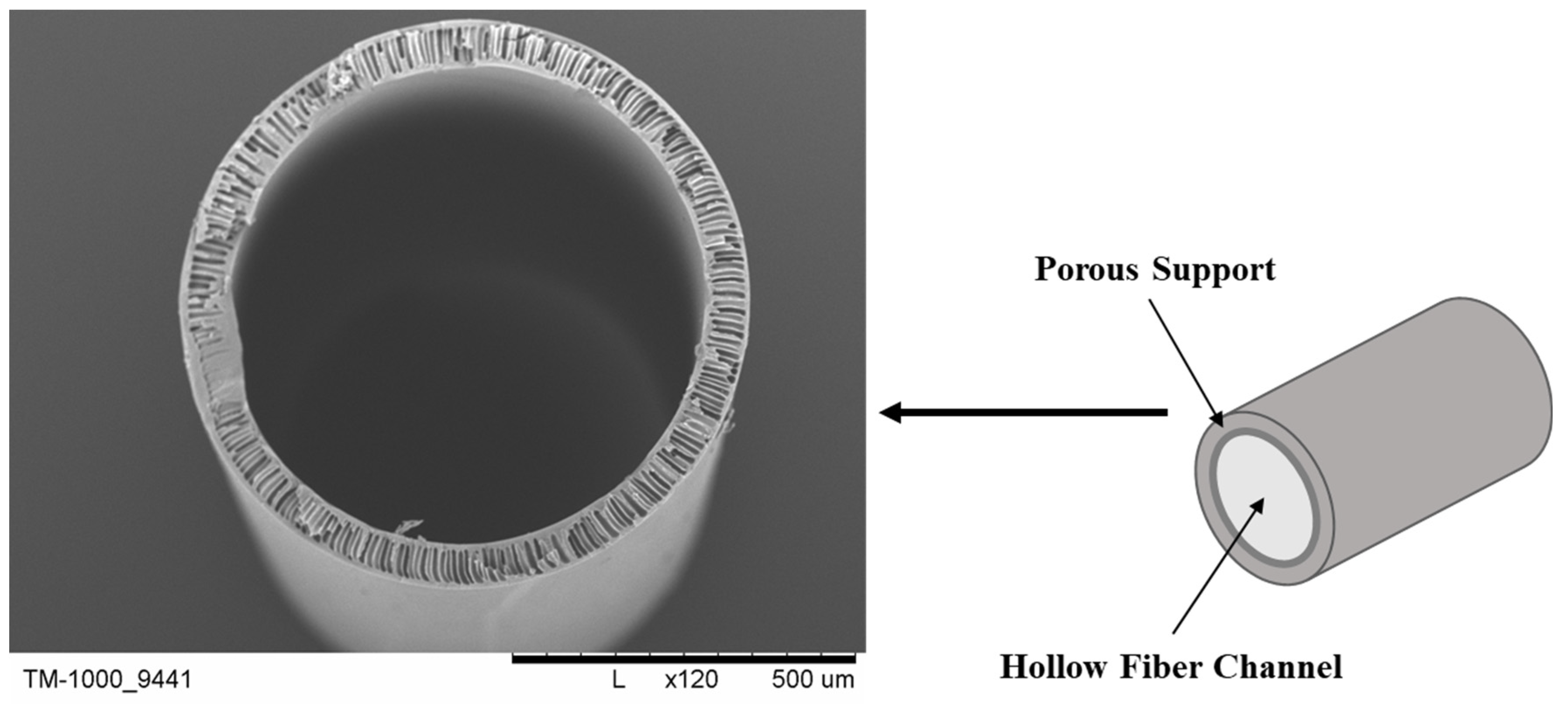



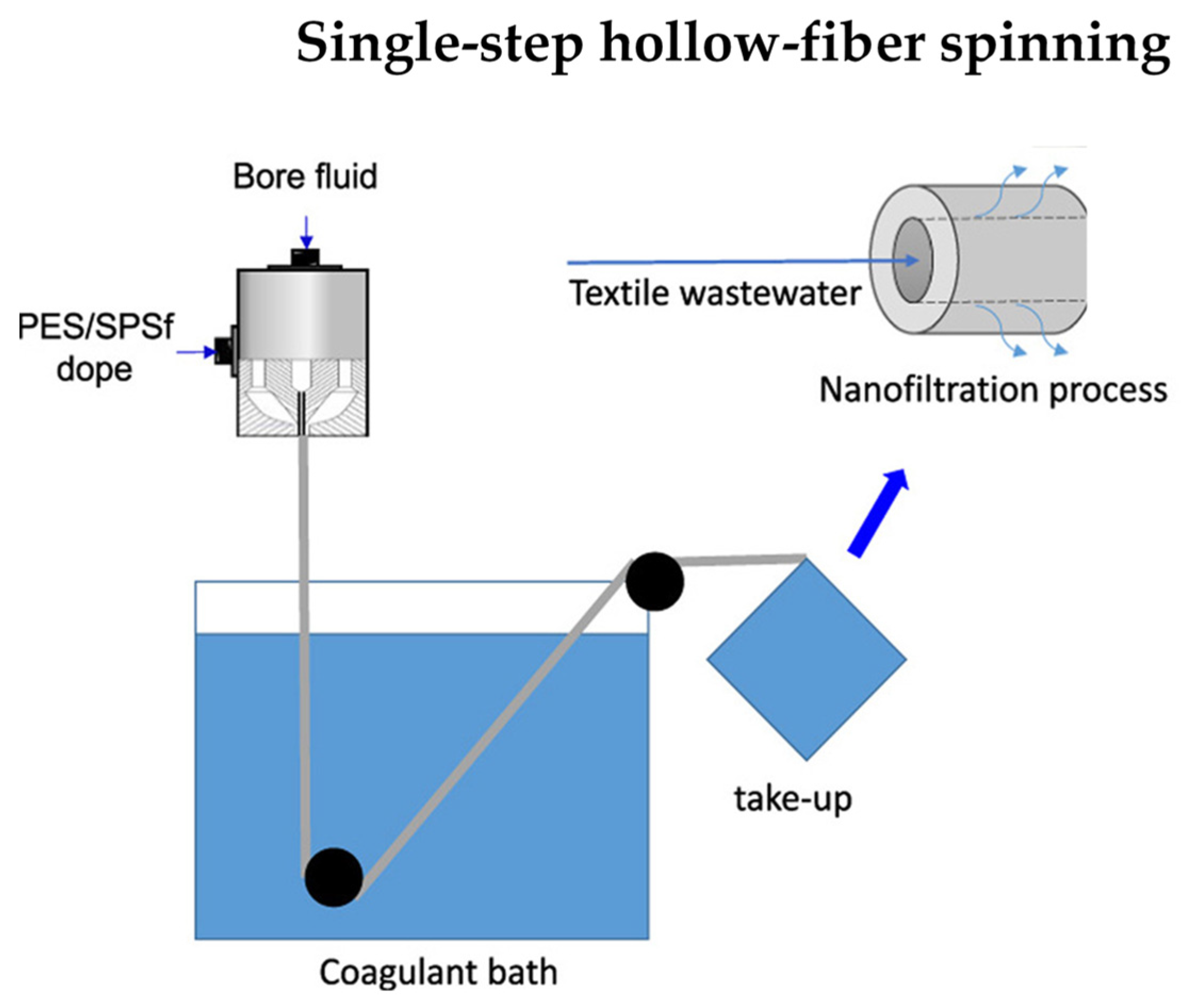

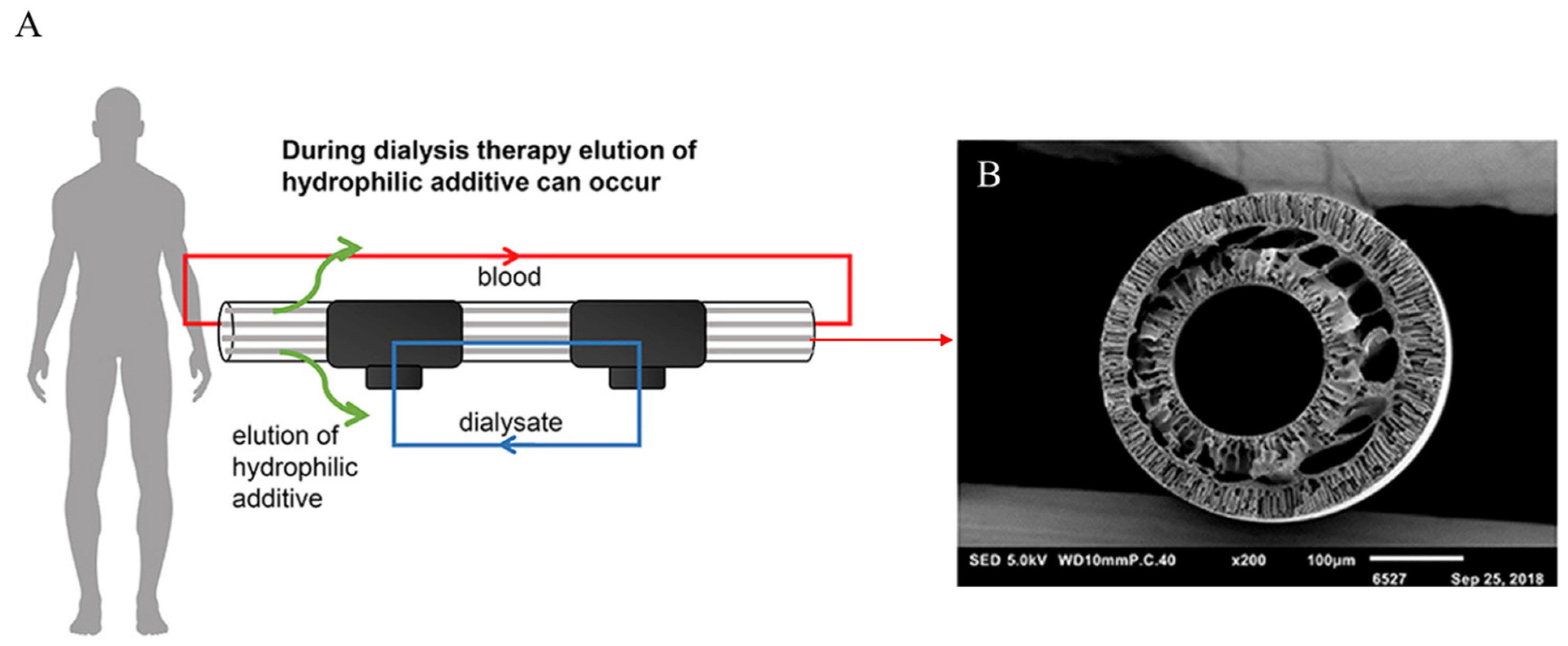


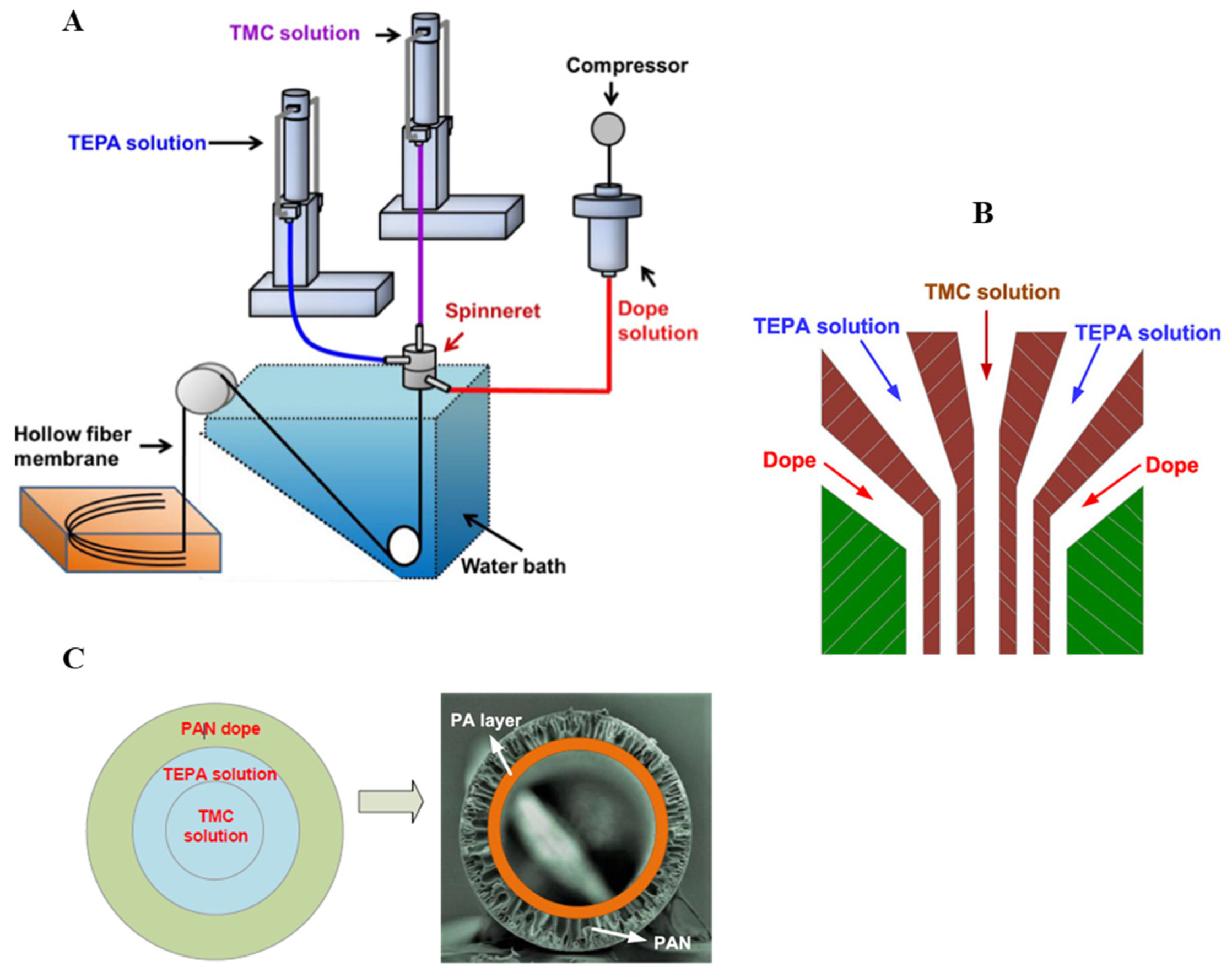
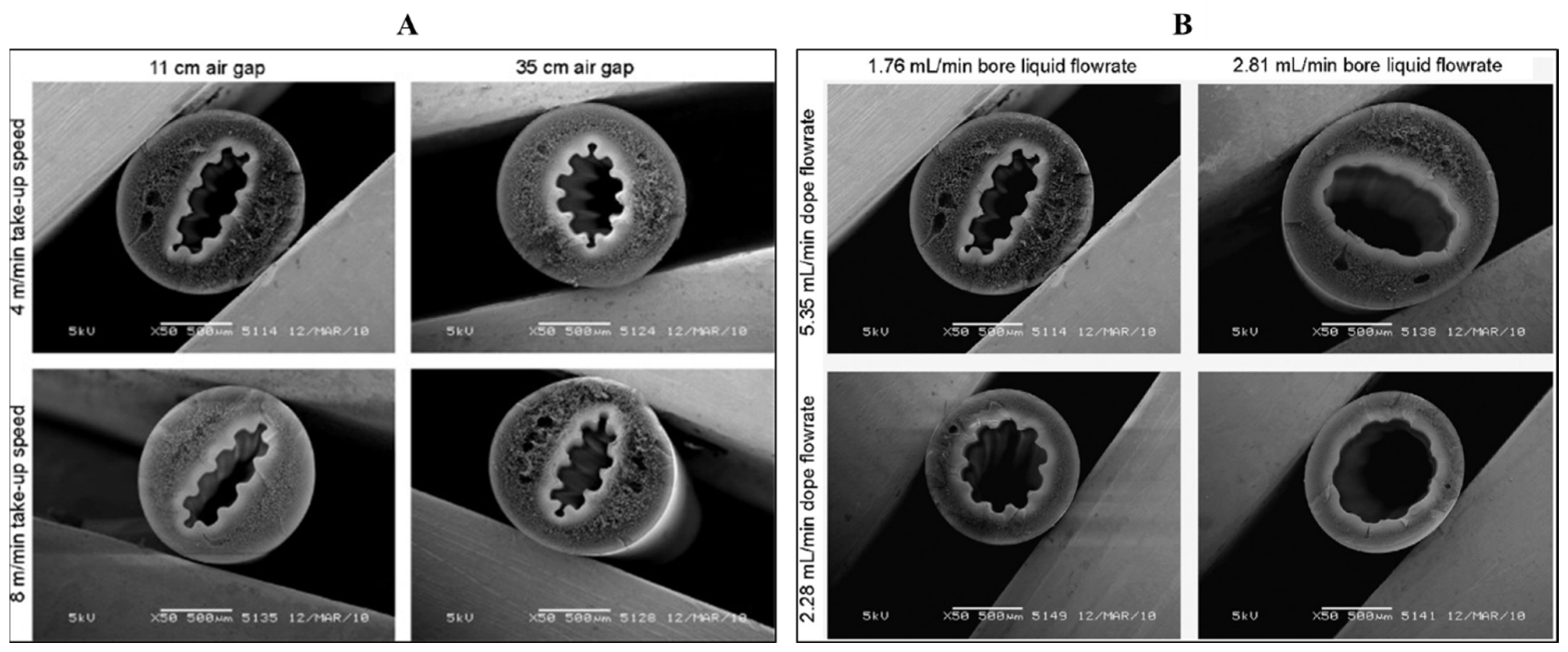
Disclaimer/Publisher’s Note: The statements, opinions and data contained in all publications are solely those of the individual author(s) and contributor(s) and not of MDPI and/or the editor(s). MDPI and/or the editor(s) disclaim responsibility for any injury to people or property resulting from any ideas, methods, instructions or products referred to in the content. |
© 2024 by the authors. Licensee MDPI, Basel, Switzerland. This article is an open access article distributed under the terms and conditions of the Creative Commons Attribution (CC BY) license (https://creativecommons.org/licenses/by/4.0/).
Share and Cite
Wojciechowski, C.; Wasyłeczko, M.; Lewińska, D.; Chwojnowski, A. A Comprehensive Review of Hollow-Fiber Membrane Fabrication Methods across Biomedical, Biotechnological, and Environmental Domains. Molecules 2024, 29, 2637. https://doi.org/10.3390/molecules29112637
Wojciechowski C, Wasyłeczko M, Lewińska D, Chwojnowski A. A Comprehensive Review of Hollow-Fiber Membrane Fabrication Methods across Biomedical, Biotechnological, and Environmental Domains. Molecules. 2024; 29(11):2637. https://doi.org/10.3390/molecules29112637
Chicago/Turabian StyleWojciechowski, Cezary, Monika Wasyłeczko, Dorota Lewińska, and Andrzej Chwojnowski. 2024. "A Comprehensive Review of Hollow-Fiber Membrane Fabrication Methods across Biomedical, Biotechnological, and Environmental Domains" Molecules 29, no. 11: 2637. https://doi.org/10.3390/molecules29112637
APA StyleWojciechowski, C., Wasyłeczko, M., Lewińska, D., & Chwojnowski, A. (2024). A Comprehensive Review of Hollow-Fiber Membrane Fabrication Methods across Biomedical, Biotechnological, and Environmental Domains. Molecules, 29(11), 2637. https://doi.org/10.3390/molecules29112637







